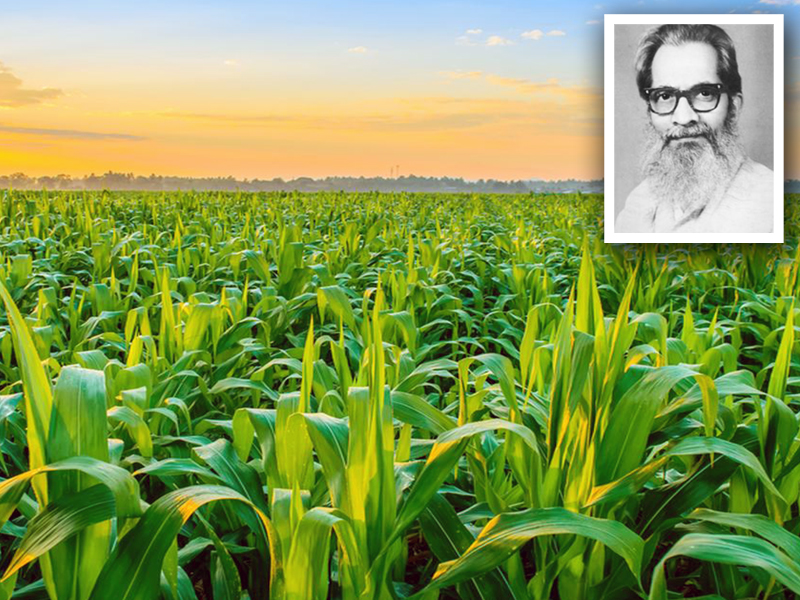Over the last few decades, Crop insurance has become a major line of business for the non-life insurance industry. What started almost as an experiment in the early years of the 80’s decade, implemented mostly as a pilot scheme, has by now evolved and metamorphosed into one of the highest revenue earning businesses in the non-life insurance segment.
But do you know who planted the seed of crop insurance in India? Who was it that devised the master plan by which this hitherto uninsurable but highly vulnerable business segment could be brought on the insurance table? One would suppose that the person would be an agriculturist with a lot of experience in cultivation and knowledge about the attendant risks in the traditional practices of the farmer. One could be pardoned for imagining that the person designing crop insurance would be an insurance man after all, perhaps with a vast experience in this domain. Since crop insurance in India runs mostly on government support, both financial and administrative, hence it would come as no surprise if the original initiator of crop insurance turned out to be a senior bureaucrat in either the Ministry of Agriculture or Finance. But was it the case? No, not by a mile!
The person who devised the original model of crop insurance, or may I say, developed the seed concept of crop insurance, was by no means an agriculturist or an insurer or even a bureaucrat. He was a professor. A Professor of Statistics. He was a statistician.
Professor Vinayak Mahadev Dandekar was born on the 6th of July 1920 and was a statistician and agricultural economics by education. He was Director of the Gokhale Institute of Politics and Economics from 1966 to 1980 (with a two year gap) and then Professor Emeritus there. He also served as executive president of the Indian Society of Agricultural Economics. He occupied many positions and was member/chairman of many Government Committees, both at the Centre and State. His contributions to the field of agricultural economics are many and varied, including Logic of Price Policy in Agriculture, Irrigation Policy, Cattle Population in the Country, and of course, Crop Insurance. Professor Dandekar passed away in Pune on the 31st of August, 1995.
Prof. Dandekar pondered over the plight of farmers, and their overdependence on the unpredictable monsoon. He realised that the farmer needed support, not only by way of seeds, fertilisers, pesticides etc., but also by way of finance. Those days the governments used to help the farmers by giving them soft loans, interest deferment, and in case of calamities, loan waivers. But Prof. Dandekar realised that these supports were all on the input side of agriculture. Farmers also required a direct financial compensatory support on the output side, in case their crops got damaged or totally lost on account of natural calamities. In other words, they needed insurance, – crop insurance.
Professor Dandekar observed that a major impediment in devising a scheme for insurance of crops had got little to do with the particular crop as such. Rather it was a problem of administration and servicing, arising out of the conflict between huge numbers and limited time. Anything associated with agriculture in India would always have huge numbers, be it the number of farmers (i.e. insureds) or number of landholdings (i.e. claims assessment units). It also had to be remembered that most of the farm holdings were located in remote areas, and were therefore difficult to reach and service. Compounding the problem was the fact that agriculture is a season-bound activity, – two seasons a year; and the cycle of insurance had to be completed before the end of the season so that the farmer would be financially restored to start on the next farming season.
Then there was the problem of the “object of insurance”. Normally, if you want to insure, say a car, its value can be assessed or determined and the Sum Insured arrived at. But in case of crop insurance, the “crop” doesn’t even exist at the beginning of the season when you take the coverage. How then do you determine the Sum Insured?
Perhaps the biggest administrative roadblock would be to reach out to the million of farmers in India, – those days there were about 12 crore landholdings, serving as an index of farm families. How could you collect Premium from so many farmers individually within a short time-window at the start of a season? This problem of numbers extends to the end-of-season also, when a large number of crop yield assessments need to be done within a very short harvesting window.
To top it all, was the question of fairness and authenticity of the activities. Insurance companies being an interested party, could be accused of bias if they did the crop yield assessment….. but who else would do it and how?
Gradually it became clear to him that crop insurance was more a problem of statistics and mathematics, and a plan had to be devised whereby insurance coverage could be taken by farmers individually, but claims could be calculated en masse in an area, i.e. collectively. Thus was born the concept of “Area approach”, which is one of the unique out-of-the-box conceptual pillars on which the framework of crop insurance stands to this day.
Professor Dandekar was up to it all. He devised a scheme which took each of these baffling problems and built solutions for each. His idea was implemented by the Government of India, in conjunction with the State Govts., and it worked!
Thus Professor V. M. Dandekar came to be known as the Father of Crop Insurance in India.
To understand the master solution of Prof. Dandekar is a fascinating journey down his brilliant mind. Understanding how he solved each of the problems through his proposed scheme would help one to get a grip on the fundamentals of crop insurance as it is implemented in India today. But more of that later.



The history lucidly explained. Keeps one engaged with interest.
A well composed trajectory of Agriculture Insurance explained in Layman terms. It is full of great insights and interesting. Hope, we will continue to receive such blogs on this platform. Thank you so much Mr Ghosh for sharing this information.
This is a very interesting and informative article. A good read!
A very informative and interesting article. A good read!
Fascinating article, and Prof. Dandekar was well ahead of times. Thanks for sharing! Today we use drones for aerial survey, water sensors for soil status, etc., and couple these with AI/ML techniques … which is also “data driven” that Prof. Dandekar leveraged.
Recent techniques for crops are likely to be per: https://www.forbes.com/sites/davidteich/2020/05/26/agriculture-industry-moves-forward-using-artificial-intelligence-ai-to-improve-crop-management/#3d3e86d4dc88